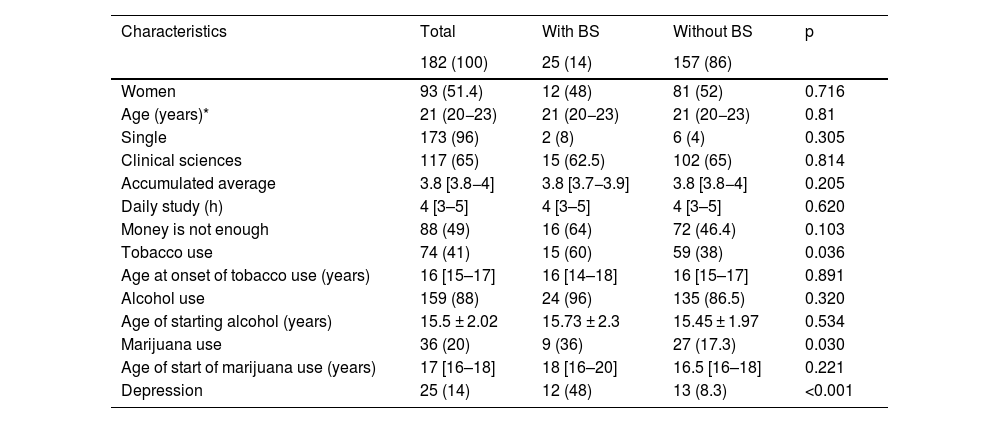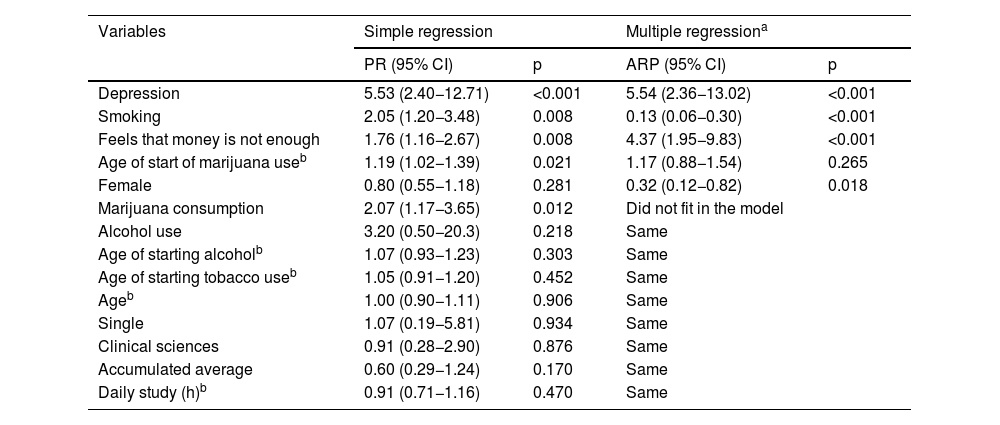Burnout syndrome (BS) has been evaluated in few populations of medical students, and its relationship with depression is even less studied. The objective was to determine the frequency of BS in medical students of the Universidad Pedagógica y Tecnológica de Colombia (UPTC), in Tunja, Colombia, as well as its association with depression and other social, economic, demographic, and academic factors.
MethodsAn observational, analytical, cross-sectional study was carried out on 182 UPTC medical students during 2018. The Maslach Burnout Inventory-Student Survey (MBI-SS) was applied, with which 3 components were obtained to determine positive SB. This was crossed in the Stata 15 program for depression and other social, economic, demographic, and academic covariates with the Generalised Linear Model (GLM).
ResultsOf 182 respondents, 51.4% were women. The median age was 21 years (20−23 years). 14% had BS, of which 48% had depression. In the multiple regression, BS was significantly associated with a higher frequency of depression (RPa = 5.54; IC95%, 2.36−13.02; P < 0.001) and the feeling of insufficient money (RPa = 4.37; IC95%, 1.95−9.83; P < 0.001), in contrast to a negative association with smoking (RPa = 0.13; IC95%, 0.06−0.30; P < 0.001) and being a woman (RPa = 0.32; IC95%, 0.12−0.82; P = 0.018). The age of onset of marijuana use was not significant.
ConclusionsBS shows a high association with increased depression and a feeling that the money is not enough at the end of the month, but it showed a negative association with tobacco consumption and being a woman. Such students should be detected to provide them with adequate academic support
El síndrome de burnout (SB) se ha evaluado en escasas poblaciones de estudiantes de Medicina, y aún menos su relación con la depresión. El objetivo es determinar la frecuencia de SB en estudiantes de Medicina de la Universidad Pedagógica y Tecnológica de Colombia (UPTC), de Tunja, Colombia, así como su asociación con depresión y otros factores sociales, económicos, demográficos y académicos.
MétodosEstudio observacional analítico de corte transversal realizado en 182 estudiantes de Medicina de la UPTC durante 2018; se les aplicó la prueba Maslach Burnout Inventory-Student Survey (MBI-SS), con lo que se obtuvieron los 3 componentes para determinar SB positivo, y se cruzó en el programa Stata 15 según la depresión y otras covariables sociales, económicas, demográficas y académicas con los Modelos Lineales Generalizados (GLM).
ResultadosDe los 182 encuestados, el 51,4% era mujeres, con una mediana de edad de 21 [20–23] años. El 14% tenía SB; de ellos, el 48% tenía depresión. En la regresión múltiple, se asoció significativamente el SB con una mayor frecuencia de depresión (RPa = 5,54; IC95%, 2,36–13,02; p < 0,001) y sentir que el dinero no alcanza (RPa = 4,37; IC95%, 1,95–9,83; p < 0,001), al contrario que la asociación negativa con tabaquismo (RPa = 0,13; IC95%, 0,06–0,30; p < 0,001) y ser mujer (RPa = 0,32; IC95%, 0,12−0,82; p = 0,018). La edad de inicio del consumo de marihuana no fue significativa.
ConclusionesEl SB sí muestra una alta asociación con el incremento de depresión y sentir que el dinero no alcanza a fin de mes, pero se mostró una asociación negativa con el consumo de tabaco y ser mujer, por lo cual se debe detectar a dichos estudiantes con el fin de brindarles un apoyo académico adecuado.









